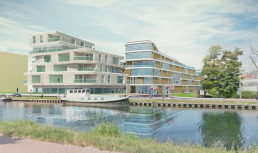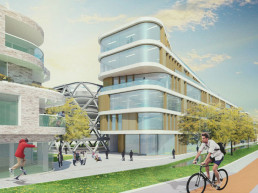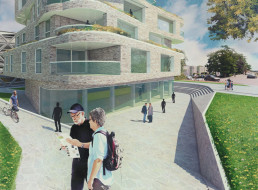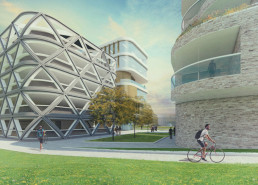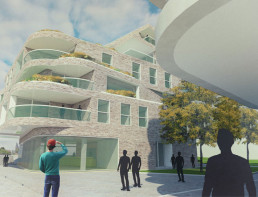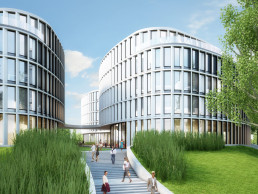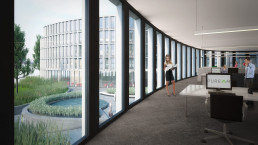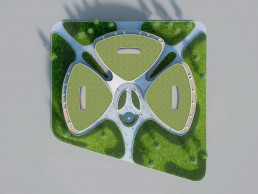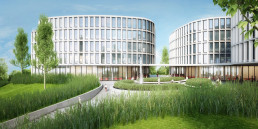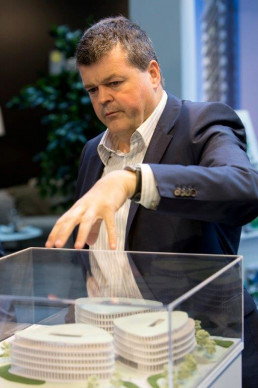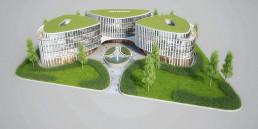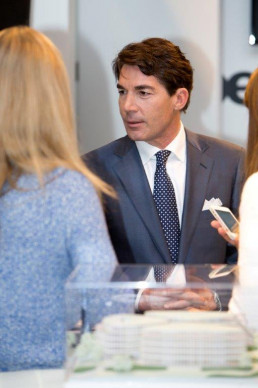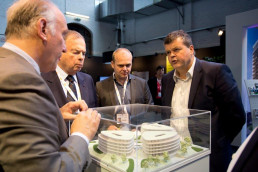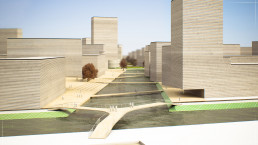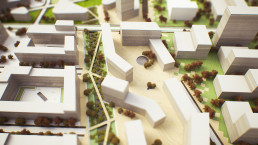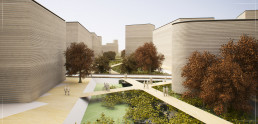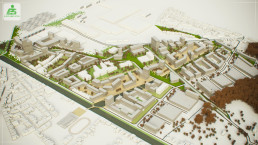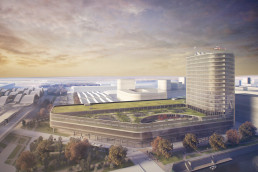“BEL M” new challenge for Ragheno Park development
“BEL M” new challenge for Ragheno Park development
Mechelen, the new centre of Belgium!
Every morning and evening, the Flemish and French-language radio stations recite the daily traffic congestions. Gridlock on the Brussels and Antwerp ring roads, delays on the N16 and the N21, congestion on the E40 at Ghent and on the E313 at Hasselt. One name you rarely hear in the daily summaries: Mechelen. A blessing for the people of Mechelen and for the city. Mechelen can promote itself as a pleasant and charming city as well as its central location and easy accessibility by road.
The City Council has been striving for some time now to further optimise Mechelen’s already excellent location and accessibility. And their efforts are paying off. Precisely because of its location between Antwerp and Brussels, Mechelen is becoming more and more popular with companies suffering from the degradation and deteriorating accessibility of these large cities. The growing number of residents demonstrates the increase in local industry. The past decade has in fact seen the number of residents in Mechelen rise by more than 7,000, bringing the population to nearly 84,000. More people are living within a 25 km radius of Mechelen’s main square than in the same radius around Antwerp and Brussels.
To exploit the city and its location’s potential even better, a large-scale redevelopment plan has been drawn up. In the plan, the area around the station will form the main hub. In the coming years, the area surrounding Mechelen’s station will undergo a complete regeneration. Not only will the city gain a new central station, the adjacent premises will be refurbished to blend in and form the new heart of the city.
The strategic extension of the large station area is one of the key aspects of Mechelen’s Municipal Structure Plan. It is the most significant urban development project taking place in Mechelen for the coming decades and will receive indisputable international acclaim. For this station area, 21st century Mechelen has decided to adopt a Sustainable Mobility concept, daring architecture and novel urban planning solutions.
These decisions involve the construction of a new railway line (Bypass) and an essential access road for people and freight transport (Tangent), the development of a multimodal railway and bus station and the reconstruction of streets and squares in the station area, resulting in traffic flow adjustments.
In this way, Mechelen Station is positioning itself as the major hub for the city’s public transport, south of the province of Antwerp and north of the province of Flemish Brabant, including for bus transport. Mechelen Station provides access to the surrounding region: both the city, the suburbs and the more remote districts. It is also where all the city and regional services stop. The new station is a few minutes’ walk from Ragheno Park.
The Tangent and the Bypass are part of the same infrastructure project, providing high-quality urban planning and architecture. Both infrastructures have been designed using an integrated approach. During the construction works, the inconvenience to the city and its residents must be minimal. The future station building – a Eurostation design created by architects Salvatore Bono and Brent Turchak – will be furnished in an attractive, user-friendly and future-oriented style.
The new station is set to become the driving force for regenerating the wider area. A mixed residential and working area will soon emerge on the southeast side of the station, bringing medieval Mechelen into the 21st century. A district should be attractive for living or just relaxing in, but above all it must welcome companies and organisations that are being confronted, elsewhere in Belgium, with space restrictions (lack of options for expansion), poor access and heavy financial burdens (too high rents). These restrictions are conspicuous by their absence in the Ragheno Park area.
Work is already in progress on part of the project area. The centralised blood transfusion service of the Flemish Red Cross was established in Ragheno Park in 2015. This marks the start of a revival of the station area that will change Mechelen’s prospects, and for the near future, definitely put the city back on the map.
To create the new project area, the city of Mechelen has opted to achieve sustainable development, on an economically feasible basis, in a socially responsible way and with minimum ecological impact on the environment.
Entirely within these essential conditions, the Beherman Group is now launching “BEL M”, its second ambitious project after “PURE M” in this area.
Bel M
The ”Bel M” project is situated in Ragheno Park’s urban area, the first area to be currently considered for development. This construction site, lying just south of the Mechelen inner ring road, is a stone’s throw from the Central Station, between Bautersemstraat, Motstraat and Hanswijkvaart. The site borders on the canal from Leuven to the river Dijle in the west.
It is in this development area that the Beherman Group established the headquarters for the centralised blood transfusion service of the Flemish Red Cross last year. The plan area will also accommodate the new office development “Pure M” designed by Jaspers & Eyers Architects.
“Bel M” is a project drawn up by DDR Architects and comprises the creation of a contemporary, multifunctional building complex including offices, a parking garage and apartments.
The entire complex, with its soft lines and pleasing colour-scheme not only meets the requirement for sustainable and flexible office units, but also provides a solution for the pressing problem in this part of the city, namely the increasing lack of parking spaces. Moreover “Bel M” also satisfies many people’s desire to be able to live on the waterfront, alongside the canal
Currently about half of the Flemish people work in office buildings. The possibilities and requirements for a modern office have changed at a rapid rate on account of social, technological and organisational developments.
However, it is essential that people who work in offices also feel at ease, and that the working environment is comfortable and energises people, at least in their field of work. “Bel M” explicitly fulfils these requirements.
For office workers, the main thing that has undergone change in recent years is the workspace. From an enclosed meeting area to a large boardroom, from an open space for deliberations to a sizeable conference room, from hot desks to fixed individual workstations, from flexible work areas without storage space to a desk flanked by filing cabinets. Architects feel more and more obliged to consider both inside and outside spaces. Also, because social developments in mobility and accessibility require them to do so. Structural progress regarding the optimization of flexibility in production processes and technical advances creates new additional opportunities to respond to the above-mentioned developments. Consequently, work will become less and less dependent on time and place. However, it remains important that a good office location stands out by being easily accessible by (motor)bike, public transport and car.
The “Bel M” location is certainly distinctive as far as the above-mentioned aspects are concerned. This is also the case from an architectural perspective, as the building is in fact made up of flexible office sections with a parking garage on various floors, largely concealed at the back of the office building. Both are flanked on the canal side by an apartment building offering various types of apartments, combined on the ground floor with small-scale restaurants and/or areas for independent professionals, subsequently culminating yet again in the diversity required of such a large-scale development.
Architecture description in powerful terms
ENTIRE PLAN
Interaction of different architectural interpretations, as a result of various complementary functions, which together form a fascinating and rich environment. In green and blue surrounded by a ring of green (BPA uncultivated garden zone) and water (wadi and canal). Integrated ‘Motstraat’ typology at the level of the public area, thus achieving a balanced streetscape on Motstraat. Morphologically connected to the surrounding buildings with volumetric growth towards the canal and the heart of the project, namely the square in between the three different interpretations. Final phase – completion of the ‘west access via canal’ section of Ragheno Park.
OFFICES
The layout features a playful combination of rounded corners and circular recesses and projections. By incorporating the curves of the entrances and terraces here and there, the façade opens up to the surrounding area in various places, on the one hand to ensure maximum communication (social interaction) and on the other hand to underline the readability and intelligibility of the space. The boundary between inside and outside fades while the façades seem to go on forever.
The gentle curves, instead of the hard, cold corners that are typical of ordinary office blocks, add continuity to the building. They evoke a connection with the adjacent canal and the boats sailing by.
The horizontal layers look characteristic of a street scene and highlight the elongated terrain. Vertical secondary elements between the layers rescale the building to human dimensions.
White is fresh and thanks to its neutrality, it soaks up the ambient colours, affording the building a lively and powerful appearance, combined with the bronze anodized aluminium which emphasises the individual identity of the office section.
The offices are ideally south-west-east facing to allow natural light in the workspace / parking north facing. Terraces for lunch break relaxation, allow light to penetrate the units and green ‘inside’ the offices.
PARKING GARAGE
Vertically positioned alongside the same premises behind the offices and apartments, with the positive effect of being mostly concealed from the streetscape.
The parking garage is not an autonomous tower block or an underlying, inaccessible ‘pedestal’ that would contribute to both anonymity and a lack of social control.
Oversupply of parking, only 85 + 14 pp are required for the new offices – apartments, which will deal with the nuisance of illegal parking and result in a high-quality public space. This will protect pedestrians and cyclists from danger.
Tension between the structurally diagonal façade elements and the spiral flow of vertical circulation. Roof grid with green elements to conceal the cars and ‘asphalt surface’ from the overall view, so that a ‘green’ and interesting spectacle is on display from the offices, apartments and adjacent buildings.
APARTMENTS
Clear focal point – beacon that connects the canal and the offices with the parking garage. Distinct presence by using the busy levels which ‘squeeze’ loose from each other, on the one hand to display ‘flower boxes’ that provide the urban fabric with the maximum amount of green, and on the other hand to create light and shade that enliven the entire monolith.
Pure M
Pure M
Introduction to the Beherman Group
The Beherman Group, with its headquarters in Bornem near Antwerp, is a Belgian multi-sector trading company that has been established for more than a hundred years. Over the years the Group has acquired a solid reputation in the Benelux for the import, distribution, production and assembly of a total of 26 brands of freight and passenger vehicles. Alongside its activities in the automotive sector, the group has focussed on other business activities in the fields of IT management and development, financial services and reinvestment, as well as residential and industrial real estate.
For the time being, the automotive sector remains the Beherman Group’s core business. Currently the enterprise is responsible for a Mitsubishi network of 58 dealers and 32 agents, for 39 FUSO distributors in Belgium and Luxemburg and 84 Saab service and repair centres in the Benelux and France. In addition the Group would like to concentrate its efforts on project development and managing residential and commercial property.
In 2012 the Beherman Group and Bopro set up the company Sustainable Development Mechelen NV (SDM). SDM has established the centralised blood transfusion service of the Belgian Red Cross Flanders in a part of the Ragheno Park in Mechelen, next to its headquarters.
On the 13 hectares owned by the Beherman Group, the finishing touches are being made to a project plan with residential and business units that will guarantee sustainable development of the area based on a healthy economic profitability, minimal environmental impact and corporate social responsibility. In the context of this huge urban renewal plan, the next office project to be launched on the market will be named ‘Pure M’.
Pure M Mechelen, the new centre of Belgium!
Every morning and evening the Flemish and Walloon radio stations recite the daily traffic congestion. Gridlock on the Brussels and Antwerp ring-roads, traffic jams on the N16 and the N21, delays on the E40 at Ghent and E313 at Hasselt. You rarely hear Mechelen mentioned in the daily traffic summaries. This is good news for the people of Mechelen, as well as for the City Council who are able to promote it not only as a charming city but also for its central location that is and will remain easily accessible. By road, at least.
Thanks to its location in the heart of the country, Mechelen is also easy to reach by train from nearly all Belgian and European cities. It takes less than 20 minutes to get there from Brussels, Leuven or Antwerp. The railway stations and the bus station are located within walking distance. The international airport Zaventem (Brussels Airport) is a 10-minute train ride away.
Despite Mechelen’s existing good location and ease of access, its Council has been working for some time to achieve further optimisation of the city’s accessibility. And for good reason; precisely because of its location between Antwerp and Brussels, Mechelen is becoming more and more popular with companies suffering from the reduced accessibility to these large cities. More local business will indeed produce more inhabitants. In the past decade, the population of Mechelen has risen by more than 7000, bringing the total number of inhabitants to 83,000. More people live in a radius of 25 km from Mechelen’s main market square than in the same radius around Antwerp and Brussels. In order to better exploit the city and its location’s potential, a large-scale redevelopment plan has been devised focussing on the area around the station.
In the coming years, the area surrounding Mechelen’s station will undergo a complete transformation. Not only will the city have a new central station, the neighbouring buildings will be refurbished and incorporated to form the new heart of the city.
The Beherman Group is a major player in this urban renewal project. The Group owns over thirteen hectares of land in this development area which is called “Ragheno Park”. Recently the Group concluded successful negotiations with the authorities to regenerate part of the terrain that is historically contaminated and for which a Brownfield covenant has been obtained. Work is already in progress on part of the project area. The centralised blood transfusion service of the Belgian Red Cross – Flanders, whose headquarters are currently under construction and will be completed this year, is located in Ragheno Park. This marks the start of a revival of the station area which will not only set Mechelen in motion in the near future but also definitely put the city back on the map.
The strategic extension of the large station area is one of the key features of Mechelen’s Municipal Structure Plan. It will be the most impressive urban development project taking place in Mechelen for the coming decades and clearly has an international dimension. In 21st century Mechelen near the station, the city has chosen to adopt a sustainable mobility concept, daring architecture and novel urban planning ideas. These will involve the construction of a new railway line (Bypass) and an essential access road for cars and lorries (Tangent), the development of a multimodal railway and bus station and the reconstruction of streets and squares in the station area, resulting in traffic flow adjustments. The Bypass needs to be constructed urgently in order to enable the speed limit to be raised from 100 km/h to 160 km/h for international trains passing through Mechelen Station so that the station’s capacity can be increased to accommodate the Diabolo and GEN projects. Mechelen Station is the largest public transport hub in the city, in the south of the province of Antwerp and in the north of the province Flemish-Brabant, also for travel by bus. Mechelen Station provides access to the surrounding region –both the city, the suburbs and the more remote municipalities. It is also where all the city and regional services stop. The new station will be a 7-minute walk from Ragheno Park.
The Tangent and the Bypass are part of the same infrastructure project that is of a high quality in terms of urban planning and architecture. Both infrastructures have been designed using an integrated approach. During the construction works, the inconvenience to the city and its inhabitants/workers must be kept to a minimum. The station building – a Eurostation design created by architects Salvatore Bono and Brent Turchak – will be furnished in a futuristic and user-friendly style.
The new station is set to become the driving force for regenerating the wider area. A mixed living and working area will emerge on the south-east side of the station, which should bring the 21st century to medieval Mechelen. A district should be attractive to live and stay in, but above all must provide space for companies and organisations that are confronted in other parts of Belgium with space limitations (no options for expansion), poor access and financial burdens (too high rents). These restrictions do not exist in the Ragheno Park area which the Beherman Group is developing with several partners.
As of 2012, the Beherman Group has signed a cooperation agreement with the experienced Eurostation team and De Paepe Group to establish the new project area. It involves sustainable development, based on sound economic profitability, which is socially accountable and has a minimum ecological impact on the area. Complying entirely with these basic conditions, the Beherman Group is now launching the first major project under the name “Pure M”.
“Pure M” is the ambitious pioneer of the further development of Ragheno Park

The “Pure M” project is situated in the city’s development area “Ragheno Park”, just south of the Mechelen ring-road and a stone’s throw from Mechelen’s Central Station. Previously the Beherman Group had single-handedly achieved the establishment of the centralised blood transfusion service of the Belgian Red Cross Flanders, next to its headquarters in the development area. This complex is currently under construction and will be completed this year.
“Pure M” is a 20,000 m² office development which aims to use top quality, contemporary architecture in order to play a pioneering role in the further development of the Ragheno district. “Pure M” was designed by Jaspers & Eyers Architects. Establishing office units along Motstraat will form a buffer zone between on the one side Motstraat and the existing railway infrastructure, and on the other side the area behind that will consist mainly of residential units. As we are talking about a considerable development, it was decided to divide the entire project into three different dimensions. This would match the scale of the project respectfully with the underlying residential area. One large building would be seen as too massive.
Three organic layers will now rotate concentrically around a central courtyard, providing an interesting volume effect with surprising views. The project opens out onto Motstraat which will get a new route in the future, thereby functioning as a major arterial road in the new part of the city. Thanks to the strategic location and modern architecture, “Pure M” will not only underline but also improve the recognisability of the new junction along Motstraat. As an iconic building in the Ragheno district, it will form the gateway for access to the new part of the city.
The idea is that the three volumes are erected above ground level. The green raised area is landscaped and underneath contains the necessary parking garages and bicycle parking. In addition it will act as a green buffer zone for the properties in the inner area. The central courtyard can be accessed from three sides. Because of this, the entire site will be accessible for pedestrians and can in the future be included as an alternative and small-scale walking route.
The project facades have distinguishing characteristics placed round the building in a continuous rational model. The vertical section is aligned with the already existing verticality of the new Red Cross building and the scale of the types of houses, thus reinforcing the volume effect of the three organic volumes. Together with the horizontal overhang panels, they also provide shade from the sun.
The compact layers offer a great amount of flexibility for the office floor layout. A standard level will be roughly 1,500 m². A landscaped layout as well as an individual office layout or a combination can be easily accommodated on one work floor. The central courtyard together with the functional hub is the key feature of the work floor. Besides providing natural light, the courtyard also has an energising impact. From within, an interesting interaction is created between the various levels, providing captivating views of the surroundings. Alongside ambitious and progressive architecture, “Pure M” also aspires to high standards in terms of energy and ecology. This matches the overall development of the new urban area, thereby reinforcing the city of Mechelen’s desire to play a pioneering role.
Ragheno Park development Mechelen
Ragheno Park development Mechelen
Over the next few years the area around Mechelen Station is to be thoroughly overhauled, with the city not only getting a new central station, but the neighbouring properties also being renovated and incorporated into the city’s new centre. Beherman is playing a major role in this urban regeneration project, with the company owning over 14 hectares of land in the planning area, known as Ragheno Park.
At present the company is in negotiations with the authorities on cleaning up an area of the site that suffered historical contamination, a job that will cost in the region of six million euros. Meanwhile a start has already been made on populating the park, and the Flemish Red Cross is building its new headquarters in Ragheno Park, which is currently under construction and set to be completed in the course of 2013. This marks the start of the regeneration of the station area that will not only transform Mechelen in the next few years but will also put it back on the map.

The strategic expansion of the large station area is one of the major objectives of the Mechelen Municipal Urban Plan, and is Mechelen’s most far-reaching urban regeneration project for the next few decades. The plan holds an international aspect and will place the city back on the map. The 21st century Mechelen Rail plan has resolutely opted to employ a sustainable mobility concept, a daring architectural and urban planning idea. The upshot is the construction of a new railway (the Bypass) and a new essential access road for cars and trucks (the Tangent) that will be part of the enlargement of a multimodal train and bus station, as well as the reconstruction of roads and squares around the station, leading to the adjusted circulation of traffic.
The Bypass construction is both necessary and urgent in order to enable a speed limit increase from 100 km/h to the 160 km/h required for international trains to pass through Mechelen Station and to increase the station’s capacity within the framework of both the Diabolo and the GEN project, as well as others.
Mechelen Station is the biggest public transport hub in the city, the southern part of Antwerp province and the northern part of Flemish Brabant, including for busses. The station provides access to the surrounding city, suburbs and the more remote towns, making it an essential stop for all urban and regional lines.
The Tangent and Bypass are part of an infrastructure project that is of a high quality in terms of its architecture and urban planning. Both the projects have to be designed and constructed using an integrated approach, with the hindrance kept to a minimum for the city, its inhabitants and its visitors.
The station building, designed by the architect Salvatore Bono, is to be built with future-orientation and user-friendliness in mind, with important aspects for it and its surrounds being recognisability, multifunctionality, the atmosphere, and that it can be easily reached and accessed, particularly by people suffering from reduced mobility. A 2000-space underground parking lot will also be built.
The bus station capacity plans will have to take into account the intention to cater to the expected growth in commuters by the train company using busses. It must be planned so that it can cater to the dynamic future capacity in a space and cost efficient manner.
The region is strategically located to the south of Mechelen’s historic centre and covers an important part of the city’s Urban Plan for renewing Mechelen, and the station area in particular. This area includes land owned by Park Ragheno, Euro Immo Star and MG Real Estate. With the urban regeneration and the area subject to the Urban Plan in mind, an underground link is planned beneath the present station parking lot and beneath (and on) the Centrale Werkplaatsen property to the Urban Plan area. All these properties are unutilised, and they can only be reused through the implementation of structural measures, both in terms of cleaning them up and by means of drawing up a new urban implementation plan (see below). The properties are connected to each other and are perfectly suited to a coordinated approach in terms of redevelopment.

